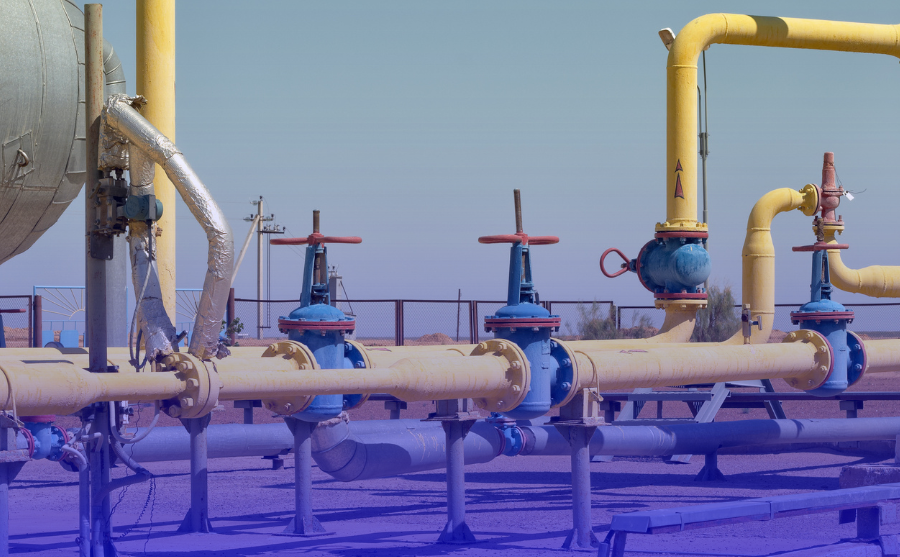

9/29/2025



When we think of gas, electricity or water, the first thing that comes to the common user's mind is probably the bill with the final consumption and the costs that go with it. However, billing is only the final expression of a very long process, involving several actors and starting from very far away. In fact, the 'supply chain' is defined as the entire process from the moment the gas is extracted to the moment it arrives and is used in the homes of end users or in industries. In this in-depth look, we will see what characterises the natural gas supply chain, which for over 40 years now has been the most widely used fuel to produce electricity and heat.
What are the steps that gas goes through before it reaches our homes? First, it must first be extracted and treated, then transported to the destination countries, distributed and, finally, marketed.
Finding a gas field is by no means a foregone conclusion. The gas is found underground, between the micropores of so-called 'reservoir rocks', usually covered with an impermeable layer of clay, which blocks its escape and ascent. In order to find the gas, it is necessary to identify where the reservoir rocks store it and, to do this, explorers carry out complex and costly geological and geophysical studies of the subsurface, with the aim of creating a 3D digital model of the subsurface.
Once a suitable area has been identified and its structure and dimensions studied, they proceed with the creation of an initial exploratory well, whose objective is to verify the actual presence of gas. If the outcome of the investigation is positive, the next step is to estimate the amount of gas present. If even in this case, the investigation shows satisfactory results (extraction is a very expensive process and, if the amount of gas is not high, the explorers do not start the next phase), then we move on to the development plan, in which the number of production wells that will actually extract the gas, their location, trajectory, type of well, etc. are defined.
After it has been extracted, the gas is treated in special plants to be fed 'clean' into the distribution systems. In the case of the Italian gas field, for example, the gas already has a very high concentration of methane (99%) and, in this circumstance, the treatment consists of separating the little natural moisture in the gas from the methane itself. In other reservoirs, on the other hand, other substances are present at the time the gas is extracted (CO2, nitrogen, ...) and this requires a more complex and economically costly treatment. Only after meticulous treatment is it then fed into the transport network, to be directed to the end users.
There are two possible ways of transporting gas. The first, the main one, is through methane pipelines, a dense and intricate network of underground steel pipes, inside which the gas, in its aeriform state, is pushed at high, medium and low pressure. Gas pipelines allow the transport of large quantities of gas, directly from the place of production to the place of consumption, without the need for any loading and storage operations. The choice of a pipeline route is based on the analysis of several alternatives depending on environmental impact, transport safety and technical-economic feasibility. It is necessary to verify that the pipeline route does not interfere with existing balances and that the pipeline itself is isolated from unstable phenomena, such as erosion processes, landslides or landslips.
The second mode is characterised by the transport of gas by LNG carriers: when transport by pipeline is not possible, because the distances to be overcome are excessive or too long a stretch of sea has to be crossed, the methane is liquefied and transported by LNG carriers. It is estimated that about 25% of the world's methane is transported this way. Methane, liquefied at -161°C, has a volume about 600 times smaller than the original natural gas. An average LNG carrier transports 130,000 cubic metres of liquefied methane, which corresponds to 78 million cubic metres in the gaseous state. However, the transport costs of LNG carriers are much higher, since several transhipments are required: the first consists of transporting the gas from the reservoir to the coast by pipeline; subsequently, the gas is liquefied and loaded onto an LNG carrier, equipped with thermally insulated tanks and sophisticated safety and environmental protection systems; once it arrives at its destination, it is unloaded at the import terminal, where it is heated, returned to the gaseous state (through the regasifier) and injected, after having reached an adequate pressure level, into the pipeline network.
Arriving in the country of destination, the gas is piped by primary pipelines into the regional network and storage areas, which allow gas stocks to be maintained to meet peak demand.
From the national and regional networks, the gas passes on to the provincial and municipal networks, which are managed for several years by local distributors. However, before being fed into the connection pipes that transport it to industries and homes, methane enters the Regulating and Measuring cabins, where it is treated a second time before entering the local distribution network. First of all, as the name suggests, these cabins measure and regulate gas. While the measurement is done using specific volumetric instruments, the regulation of gas, on the other hand, involves the reduction of pressure: the gas is subjected to a process that lowers the pressure to a predefined threshold.
In addition to these two basic functions, other functions are also performed inside the cabins:
Subsequently, the gas becomes ready to be fed into the network and reach the end users, not before, however, the distributor is sure to keep it at a pressure between 19 and 32 mBar, as we have explained in this in-depth article.
Closing the supply chain is the trading and sale of the gas service, which takes place in two stages. The first negotiation, in fact, takes place between the importing and selling company: the suppliers purchase the raw material generally on the wholesale market, and subsequently apply a profit margin before selling the gas to the end user.
Moreover, each end consumer, since the introduction of the free market, has the possibility of choosing the company that proposes the economic offer that best meets their economic needs.
External Sources

Want to know more?
We’d be happy to talk more in detail about your needs and explore how we can become your ideal partner, to assist you in your business venture of innovation, digitization and sustainability